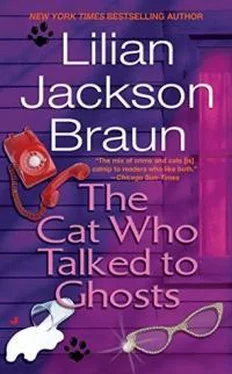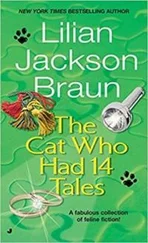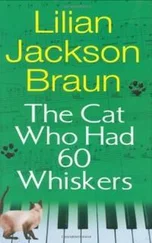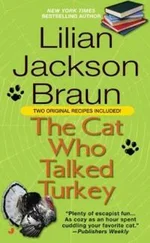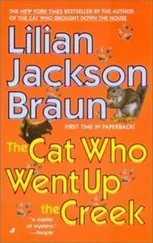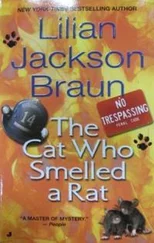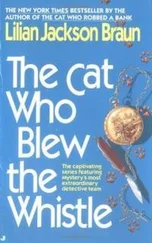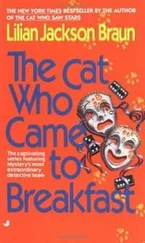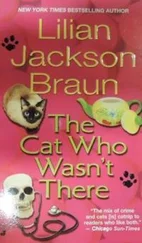"Don't let her in," Adam said.
Qwilleran called out, "One more minute, please." The door closed, and he said to Adam, "Do you know why the Goodwinters paid extra for the funeral."
Adam wiped his mouth. "It were hush money. Paw wouldn'ta took it if he warn't beholden to the bank. Paw were a religious man."
"I'm sure he was! But what were the Goodwinters trying to hush up?"
Adam wiped his mouth again. "Wal, Titus said the man were trampled to death, but when Paw picked up the body. there were only a bullethole in the head."
There was another tap on the door. The old man's chin sank on his chest again, but he revived enough to make a swipe at the skirt of the canary when she came in to wheel him to his room.
Driving back to North Middle Hummock Qwilleran was thinking, Mitch Ogilvie was right on one point: Old Adam knew a thing or two. The story of the double hoax was plotted with enough dovetailing details to make it convincing - in Moose County, at any rate, where the incredible is believable... And yet, was it really true? Adam Dingleberry had a reputation as a practical joker. Telling a cock-and-bull story about Ephraim could be his final joke on the whole county. Telling it to the media would be a virtual guarantee that it would be leaked. What headlines it would make! GOODWINTER HANGING A HOAX! MINE OWNER DIED ABROAD IN 1935! The wire services would pick it up, and Qwilleran's byline would once more be flashed nationwide.
But how would Moose County react? The Noble Sons of the Noose - whoever they were - might trash the Dingleberry funeral home with all its lavish d‚cor, not yet paid for. They might even go after Junior Goodwinter, managing editor of the Somethin great-grandson of the original villain. Qwilleran had a responsibility here, and a decision to make. The double hoax might be a triple hoax.
-20-
ARRIVING AT THE farhlhouse, Qwilleran made straight for the stereo, followed by two Siamese with waving tails. "Adjust your ears," he instructed them. "You're about to hear an astounding tale."
If the cats were expecting Verdi, they were disappointed. Adam's high-pitched voice crackled from the speakers: "Yup. My grampaw come from the Old Country to build shafthouses for the mines..."
Their ears swiveled nervously until they heard a deep voice saying, "What kind of furniture, Mr. Dingleberry?"
At the familiar sound Koko rose on hind legs and pawed the player while Yum Yum purred enthusiastically.
"Thank you," Qwilleran said to them. "I admit I was in good voice."
The old man was saying, "They was all a bit different: doors, no doors, one drawer, two drawers, false bottom, built-in lockbox, pigeonholes, whatever folks wanted."
"Yow!" said Koko, and Qwilleran felt a familiar quiver in the roots of his moustache. He turned off the sound.
Mrs. Cobb's ugly desk was a Dingleberry; no matter what its value on the local market, Qwilleran still thought it ugly. It had tall legs, a cupboard with doors, no pigeonholes, one drawer, not two. Did it have a false bottom? He removed the drawer and inspected it, shook it, pressed the bottom in several places, felt around the perimeter with his fingertips, hit the sides with the flat of his hand, shook it again. The bottom was thicker than normal, and something was shifting inside it.
"I may need some help here," Qwilleran said, and the cat sniffed and pawed while the man ran his hand over the surfaces and pressed experimentally at vital points. Unaccountably the bottom of the drawer popped up at one end, and Qwilleran pried it out.
There were no jewels concealed in the false bottom; no doubt Mrs. Goodwinter had taken them to Switzerland. There were documents, however, that gave him a psychological chill, as if he were invading a tomb, and he built a fire in the fireplace before spreading the musty papers on the hearth rug. There were bills, receipts and promissory notes. He recognized the writing on one such document:
Rec'd of Titus Goodwinter the sum of three thousand dollars ($3,000) in compensation for the accidental death of my husband. Signed this day of Oct. 31, 1904.
Lucy Bosworth
Had Titus dictated it? Had Lucy written it under duress? Or had she been an accomplice in the plot? The receipt led Qwilleran on a wild gallop of speculation regarding the young woman's relationship with her husband and, for that matter, with Titus, who was a notorious womanizer. It was clear that the payoff financed the purchase of the Pickax General Store, $3,000 being an enormous sum in the days when a family of six could live nicely on five dollars a week. The blood money, so to speak, may have paid for the impressive bible as well, a status symbol of its day.
There were other documents of historic interest if one had the time to study them, including promissory notes at abnormally high interest rates, signed by names well-known in Moose County, among them the thriftless Captain Fugtree. Ephraim's banks may have operated legitimately, but in his private money-lending he was guilty of usury.
The handwriting on a receipt dated October 28 caught Qwilleran's attention. It was the same small bold script found in Ephraim's suicide note, but it was signed by the financially captive storekeeper and undertaker, Adam Dingleberry's "Paw." Driven by debt to set aside his religious scruples, he had signed the following:
Rec 'd of Ephraim Goodwinter, the sum of two thousand dollars ($2,000) in consideration of which the undersigned agrees to bury an empty coffin with full ceremony in the Goodwinter plot in the Pickax Cemetery, payee to conceal the arrangements noted above from all living souls and future descendants, on condition of which payer agrees to make quarterly payments of five hundred dollars ($500) until such time as payer departs this life. Signed and accepted this day of Oct. 28, - 1904.
Joshua Dingleberry
A similar agreement with Titus Goodwinter, covering the interment of Luther Bosworth, also bore Joshua's signature.
The Siamese, attracted by the heat from the burning logs or the stale aroma of the documents, were in close attendance, and Koko was particularly interested in a folded sheet of paper that had been handled by dirty hands. It was a rough diagram with measurements and other specifications noted in faded penciling that Qwilleran could not decipher even with his reading glasses. Using a magnifying glass from the telephone desk he was able to identify the central element as a half-circle with dimensions given in feet. Two rectangles connected by a pair of parallel lines were marked SW and NW, but no dimensions were specified. Folded in with the diagram was a misspelled bill from the Mayfus Stone Quarry on Sandpit Road: "4 lodes stone to pave carage house." The date was May 16, 1904, and it was marked "pd."
"Three days after the explosion!" Qwilleran observed. "What do you two sleuths make of that? The carriage house is not paved; it's plank like the threshing floor. And what's this?"
Folded in with the diagram was a small slip of paper in Ephraim Goodwinter's unmistakable hand:
Rec'd of Ephraim Goodwinter the sum of one thousand dollars ($1,000) in consideration of which the undersigned agrees to do stonework as specified, privately and without help and without revealing same to any living soul, work to be completed by August 15 of the current year. Signed and accepted this day of May 16, 1904.
Luther Bosworth X (his mark)
"Luther couldn't even write his name!" Qwilleran exclaimed. "How do you like that?"
Hearing no reply he looked for the cats. Yum Yum was asleep on the hearth rug with her tail curled comfortingly over her nose. A hump in one of the other Orientals indicated that Koko was in hiding again. In consternation Qwilleran went to the telephone and called a number in Mooseville.
"Hello, Lori. This is Qwill," he said.
Читать дальше
